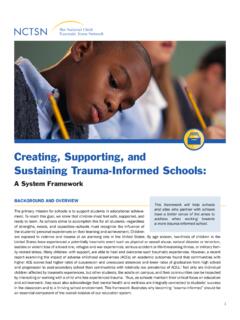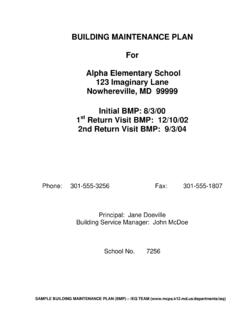Transcription of HEADQUARTERS, DEPARTMENT OF THE ARMY
1 ATP Army Team building OCTOBER 2015 DISTRIBUTION RESTRICTION: Approved for public release; distribution is unlimited. HEADQUARTERS, DEPARTMENT OF THE ARMY This publication is available at Army Knowledge Online ( ). To receive publishing updates, please subscribe at ATP Distribution Restriction: Approved for public release; distribution is unlimited. i Army Techniques Publication No. Headquarters DEPARTMENT of the Army Washington, DC, 30 October 2015 Army Team building Contents Page PREFACE .. iii INTRODUCTION .. iv Chapter 1 FUNDAMENTALS OF TEAM building .. 1-1 Team building Fundamentals .. 1-1 Team building 1-2 Characteristics Of Effective Teams.
2 1-4 Categories Of Teams .. 1-5 Roles and Responsibilities .. 1-6 Team Members .. 1- 12 Chapter 2 FORMATION STAGE .. 2-1 Assemble the Team .. 2-1 Build Trust .. 2-6 Team Communication .. 2-9 Rapidly Formed Teams .. 2- 11 Chapter 3 ENRICHMENT STAGE .. 3-1 Build Commitment .. 3-1 Build Shared Competence .. 3-3 Build Shared Confidence .. 3-3 Motivate Team Members .. 3-3 Build Shared Accountability .. 3-5 Develop Cohesion .. 3-5 Chapter 4 SUSTAINMENT STAGE .. 4-1 Adapt To Change .. 4-1 Manage Conflict .. 4-2 Sustain Resilient Teams .. 4-4 Appendix A TEAM ASSESSMENTS .. A-1 Assessing External Teams .. A-2 Appendix B EXTERNAL TEAMS.
3 B-1 Contents ii ATP 30 October 2015 GLOSSARY ..Glossary-1 REFERENCES .. References-1 INDEX .. Index-1 Figures Figure 1-1. Army team building process .. 1-2 Tables Table 4-1. Techniques for adapting to team changes .. 4-2 30 October 2015 ATP iii Preface building cohesive teams through mutual trust is a principle of mission command and an essential skill for Army leaders. ATP , Army Team building , expands upon this principle by offering fundamentals of team building and specific techniques for building and maintaining effective teams. This ATP describes the major activities of Army team building .
4 This ATP also provides a method for team assessments. To comprehend the doctrine contained in this publication, readers should understand the fundamentals of leadership found in ADP 1, ADRP 1, ADP 6-0, ADRP 6-0, ADP 6-22, ADRP 6-22, and FM 6-22. The principal audience for this publication is Army commanders, directors, staff officers, and leaders. Trainers and educators throughout the Army will also use this publication. Commanders, staffs, and subordinates ensure their decisions and actions comply with applicable , international, and, in some cases, host nation laws and regulations.
5 Commanders at all levels ensure their Soldiers operate in accordance with the law of war and the rules of engagement. (See FM 27-10.) ATP uses joint terms where applicable. Selected joint and Army terms and definitions appear in both the glossary and the text. For definitions shown in the text, the term is italicized and the number of the proponent publication follows the definition. ATP applies to the Active Army, the Army National Guard/Army National Guard of the United States, and the United States Army Reserve unless otherwise stated. Headquarters, Army Training and Doctrine Command, is the proponent for this publication.
6 The preparing agency is the Combined Arms Doctrine Directorate, Army Combined Arms Center. Send comments and recommendations on a DA Form 2028 (Recommended Changes to Publications and Blank Forms) to Commander, Army Combined Arms Center and Fort Leavenworth, ATTN: ATZL-MCK-D (ATP ), 300 McPherson Avenue, Fort Leavenworth, KS 66027-2337; by e-mail to or submit an electronic DA Form 2028. iv ATP 30 October 2015 Introduction Army organizations rely on effective teams to complete tasks, achieve objectives, and accomplish missions. The ability to build teams through mutual trust and maintain effective, cohesive teams throughout military operations is an essential skill for commanders, staffs, and all Army leaders.
7 Leaders are faced with many different types of missions and joint operations in an operational environment. The size of a team, the diversity of the team, the structure of the team, and the organizations and unified action partners that team members come from can make building and maintaining effective teams a constant challenge for leaders. Teams are an essential part of the Army. The Army could not accomplish missions without teams. To get the most from a team, the team must be cohesive and effective, which does not just happen by chance. It takes work and time to develop a team.
8 Once the team achieves a high level of cohesion, it is critical to sustain it at that level for the life of the team. Having tools and techniques for assessing the team s performance is important. Having accurate assessments of the team, the individual members, and the team leaders lets the team know what is working and what needs improvement. In May 2012, ADP 6-0 and ADRP 6-0 established build cohesive teams through mutual trust as a principle of mission command. This ATP helps commanders, staffs, and all Army leaders to understand team dynamics, and it offers techniques to help build cohesive and effective teams.
9 The potential benefits for using the team building techniques in this ATP include Increasing mutual trust among all team members and with other teams. Enhancing collaboration between team leaders and team members. Developing adaptable teams able to function effectively in uncertain environments and situations. Helping teams develop shared vision, trust, competence, and 1 begins with discussing the fundamentals of team building , including descriptions of a team, teamwork, and team building . It then discusses the stages of team building and the characteristics of effective teams. It describes the categories of teams and concludes with the responsibilities of team leaders and team members.
10 Chapter 2 discusses the formation stage of team building beginning with a description of how to assemble a team. It then discusses the importance of building trust, and it concludes with a discussion of how communication contributes to team effectiveness. Chapter 3 begins with a discussion of the importance of building commitment during the enrichment stage of team building . It then describes shared competence, confidence, and accountability and how they contribute to the effectiveness of teams. The chapter then discusses techniques to motivate teams and team members, and the chapter concludes with a discussion on developing cohesion to enhance the performance of teams.


















